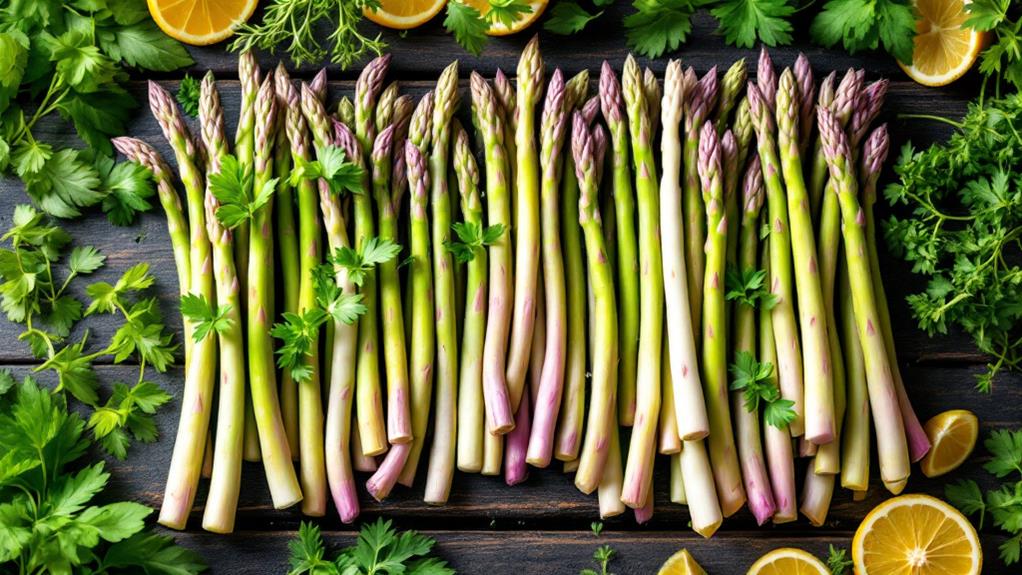The Ultimate Guide to Anthurium: Growing and Care Tips
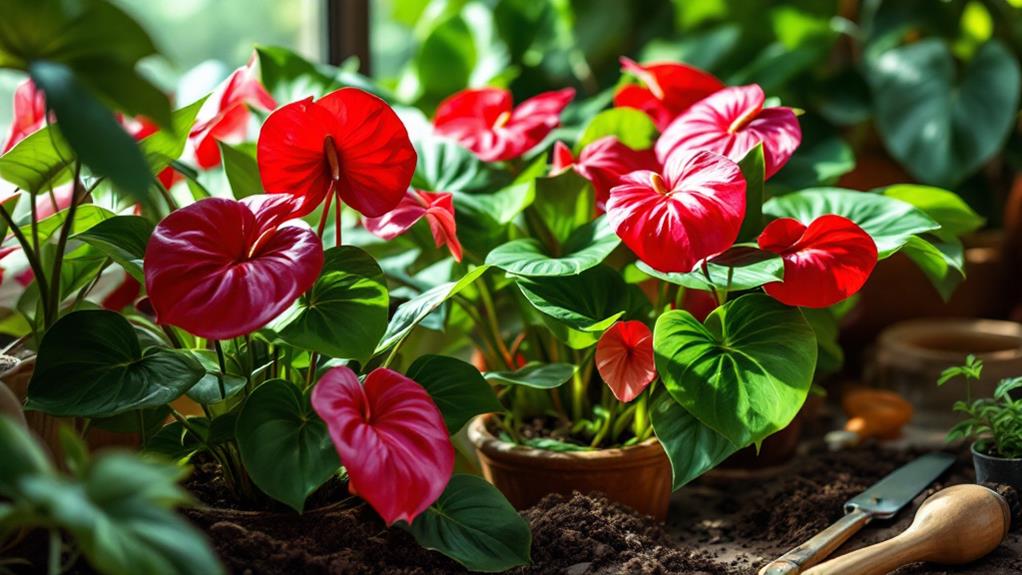
To keep your Anthurium thriving, make certain it's in a warm spot with temperatures between 65°F and 85°F, avoiding anything below 50°F. They love indirect light to prevent leaf burn and prefer humidity above 50-60%. Water them thoroughly only when the top two inches of soil are dry; too much water causes root rot. A soil mix of equal parts sphagnum moss, coco coir, and succulent mix works best. Monthly fertilization during the growing season is ideal, and watch for pests like mealybugs. Prune regularly for lush growth, and know that there's a lot more you can master about Anthurium care.
Anthurium Characteristics
Anthuriums, often called Flamingo Flowers or Red Peace Lilies, are enchanting plants native to tropical regions, known for their heart-shaped leaves and lively, waxy flowers. These long-lasting flowers can bloom in different lively colors like red, white, pink, and purple, making them a striking enhancement to any indoor space. The Anthurium andraeanum is the most commonly sold species for houseplants and typically grows to heights of 10 to 20 inches, thriving in pot sizes of 4 to 6 inches.
You'll find that Anthuriums have a slow to moderate growth rate, which can be influenced by the environment they're in. They thrive best in high humidity levels of 50-60%, crucial for maintaining their lush appearance. As indoor plants, Anthuriums require special care tips to guarantee they continue to flourish and maintain their beauty.
Ideal Growing Conditions
To guarantee your Anthuriums maintain their enchanting beauty, it is crucial to provide them with the right growing conditions. Start by confirming they thrive in warm environments with temperatures ranging from 65°F to 85°F. Avoid exposing them to cold temperatures below 50°F, as this can hinder their growth. Indirect sunlight is ideal for Anthuriums, protecting their foliage from leaf burn, but brighter spots may be needed in winter.
Humidity plays an important role in their health. Aim for levels above 50-60%. You can increase humidity by placing pebble trays filled with water near your plants or using a humidifier. Proper watering is another significant care tip. During summer, water your Anthuriums weekly, and in winter, reduce the frequency to every 10-14 days. Let the top two inches of soil dry slightly between waterings to prevent root rot.
Selecting the right soil mix guarantees superior growth. A coarse, porous mix composed of 1/3 sphagnum moss, 1/3 coco coir, and 1/3 succulent/cactus mix facilitates drainage and keeps roots healthy. Adhering to these growing conditions will help your Anthuriums flourish, displaying lively foliage year-round.
Light and Temperature Needs
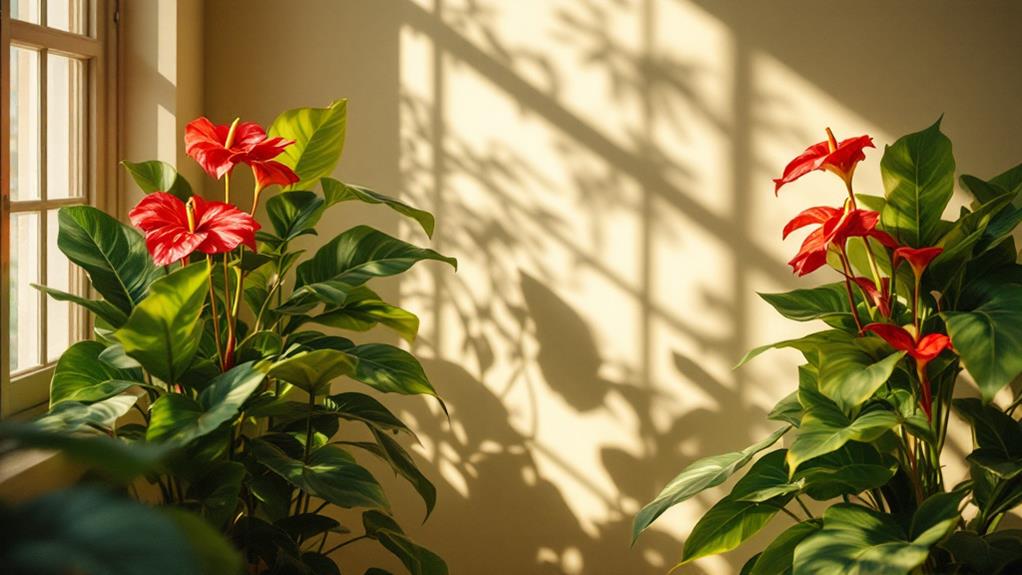
Understanding the light and temperature needs of your Anthuriums is fundamental for their ideal growth. These tropical plants thrive in moderate light conditions, so it's important to avoid direct sunlight, which can scorch the leaves and stunt growth. Instead, place your Anthuriums in a spot where they receive filtered light. During winter, as daylight hours shorten, you might need to move them to a brighter location to guarantee they continue thriving.
Temperature is another important factor to take into account. Anthuriums flourish in temperatures ranging from 65°F to 85°F (18°C to 29°C). If temperatures drop below 50°F (10°C), their growth can halt, so maintaining a stable environment is key. High humidity also plays a significant role in encouraging blooming and extending the life of their flowers.
To keep your Anthuriums in ideal conditions, regularly monitor the light levels. Yellowing leaves may indicate too much direct sunlight, while dark green leaves suggest insufficient light. By adjusting their placement and guaranteeing proper light exposure, you'll prevent stress and promote healthy growth. These care tips will help you create the best environment for your Anthuriums, enhancing both their beauty and longevity.
Watering and Humidity Tips
When caring for Anthuriums, proper watering and humidity are important for their health and vitality. Start by checking the soil moisture; water your Anthuriums thoroughly when the top two inches feel dry. Typically, you'll water once a week during summer and every 10-14 days in winter. Overwatering can lead to root rot, so it's imperative to confirm the pot has good drainage. Check that your pot has adequate drainage holes to allow excess water to escape and avoid waterlogged soil.
Humidity plays a significant role in keeping your Anthuriums thriving. Aim for humidity levels above 50-60% to prevent brown leaf tips and stress. If your home is on the drier side, consider misting the leaves regularly or placing the plant on a pebble tray filled with water to increase humidity around the plant naturally. These care tips will help create an environment that mimics their native tropical habitat.
Additionally, use a well-draining soil mix that retains some moisture while allowing excess water to flow through. A combination of sphagnum moss, coco coir, and succulent/cactus mix works well. Following these guidelines will keep your Anthuriums happy and healthy.
Best Soil Mix
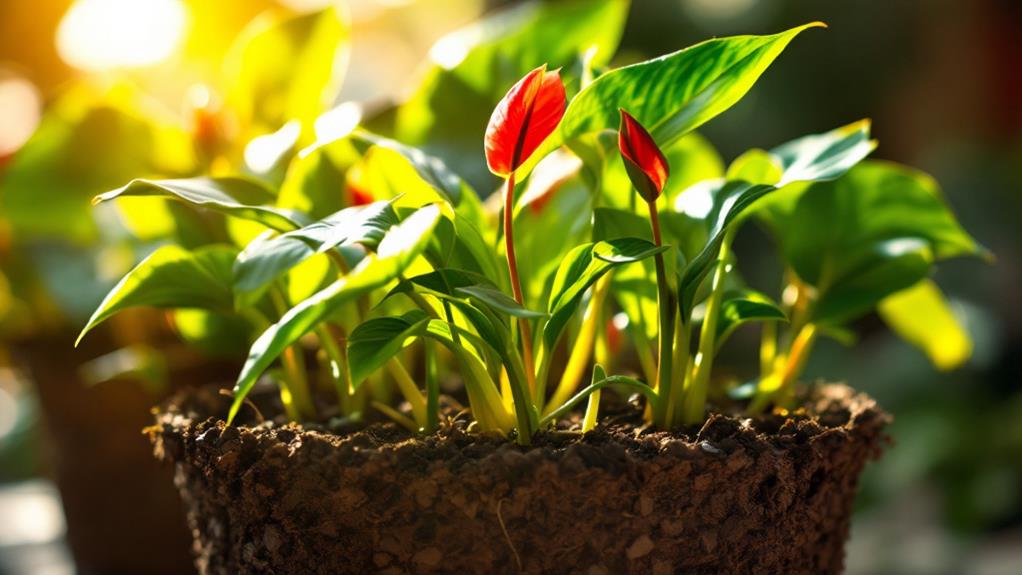
While guaranteeing proper watering and humidity is crucial for Anthuriums, selecting the best soil mix is just as significant for their all-encompassing health. Anthuriums thrive in a coarse, porous soil mix that mimics their natural epiphytic habitat, promoting excellent drainage and aeration. A recommended soil mix includes 1/3 sphagnum moss, 1/3 coco coir, and 1/3 succulent or cactus mix. This combination guarantees moisture retention without risking waterlogging, which can lead to root rot.
For those seeking alternatives, consider mixing 1/2 peat moss or coco coir with 1/2 orchid bark. This blend improves drainage and nutrient availability, creating ideal growing conditions. Regardless of the mix you choose, make sure that the pot has multiple drainage holes. This prevents water accumulation and protects the Anthurium's roots.
Regularly check your soil for signs of degradation. Repotting every 2-4 years helps maintain the perfect environment for your Anthurium. Fresh soil rejuvenates the plant by providing new nutrients and improved aeration. By focusing on a well-structured soil mix, you'll create the perfect foundation for your Anthurium to flourish and showcase its stunning foliage.
Fertilization Advice
To foster lively blooms and healthy growth in your Anthuriums, it's vital to fertilize them once a month during the growing season, which spans spring and summer. Use a diluted liquid fertilizer, specifically one high in phosphorus, to encourage lively blooming. A quarter-strength solution is significant to prevent over-fertilization, which can lead to salt build-up and harm the plant's roots.
It's necessary to monitor your Anthuriums regularly for signs of nutrient deficiencies, such as yellowing leaves. If you notice these symptoms, consider adjusting your fertilization routine. Perhaps your plant requires a slight increase in nutrients, or you might need to switch to a different fertilizer to meet its needs more effectively.
Pruning and Propagation
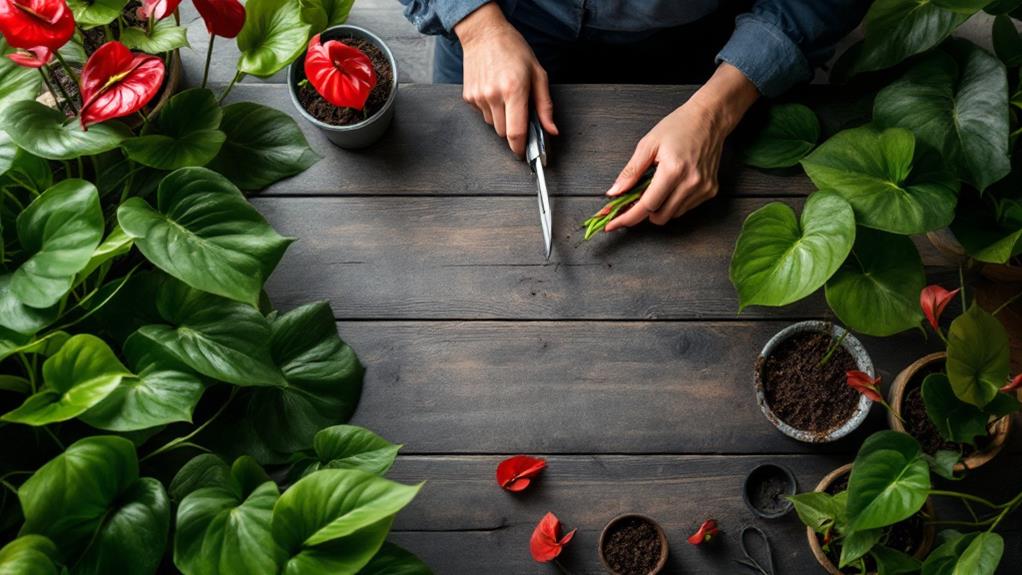
Pruning and propagating your Anthurium can greatly improve its health and appearance. Focus on removing older leaves and spent flowers at the base. This encourages new growth and can be done year-round. Always maintain at least three to four healthy leaves after pruning to guarantee the plant remains lively.
For propagation, using side shoots or pups is the most effective method. It's faster and safer than stem cuttings, with new growth typically appearing within 4 to 6 weeks. If you do choose stem cuttings, be sure to leave new buds on the main stem to keep the plant thriving. Confirm you're using a clean pot and well-draining soil to promote root establishment and general growth.
Division is another reliable method for quick results. It allows you to separate the plant into smaller sections, each having its own root system. Starting from seeds isn't practical for Anthuriums, as it may take around four years for them to bloom. By focusing on division and cuttings, you'll see quicker results and a healthier plant. Regardless of you're pruning or propagating, these practices will lead to a flourishing Anthurium in no time.
Repotting Guidelines
Repotting your Anthurium is crucial for its continued growth and health. To maintain your plant's vigor, aim to repot every 2-4 years or when you notice signs of root crowding. Spring or summer is the best time to undertake this task, as it promotes healthy growth. When choosing a new pot, make sure it's only about 2 inches larger in diameter than the previous one. This helps manage soil moisture effectively and prevents the risk of root rot.
Use a well-draining soil mix tailored for epiphytes. A recommended combination includes 1/3 sphagnum moss, 1/3 coco coir, and 1/3 succulent or cactus mix. This blend provides the ideal environment for your Anthuriums, aiding in proper drainage and reducing the chance of waterlogging. Always select a pot with multiple drain holes to guarantee excess water escapes easily.
Keep an eye out for soil degradation, which can also signal the need for repotting. Regularly check the soil's condition and moisture levels, as this helps maintain the right balance for your plant's requirements. By following these guidelines, you'll make certain your Anthuriums thrive and stay healthy.
Pest Management
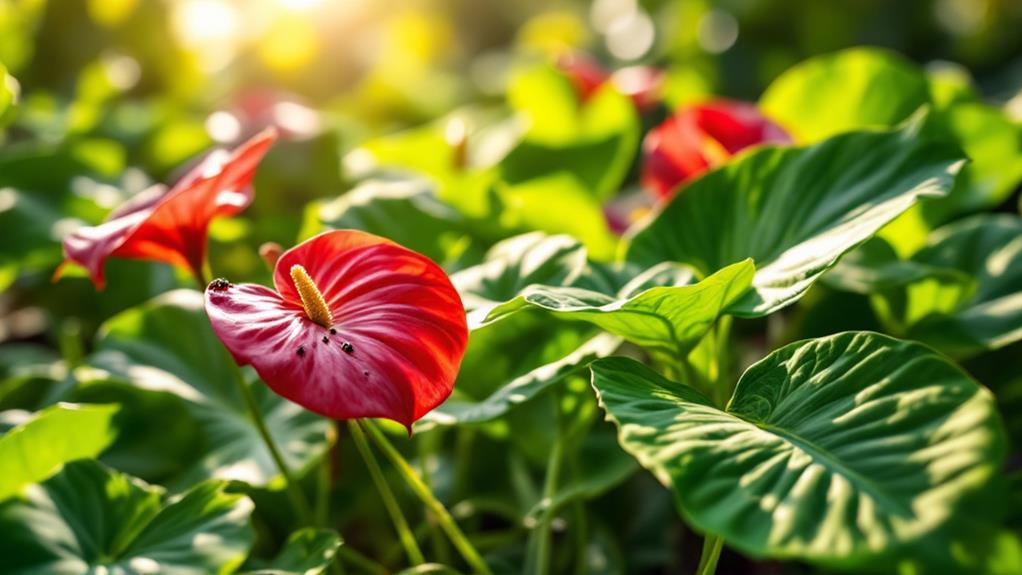
Dealing with pests is an inevitable part of Anthurium care, but prompt action can save your plants from significant damage. Common pests like mealybugs and spider mites can wreak havoc if infestations aren't caught early. Regularly inspect your Anthuriums for signs of trouble, such as white cotton-like masses from mealybugs or webbing from spider mites. Early detection is essential in effective pest control.
To manage pests, consider using natural methods. A strong water blast can dislodge many pests, while stubborn infestations might require horticultural soap or oil sprays. These gentle approaches help avoid harming your plants while tackling the pest problem. It's also wise to quarantine any new plants before adding them to your collection, preventing potential pest spread.
Maintaining proper plant hygiene is key. Keep ideal humidity levels and avoid overwatering, as damp conditions can attract pests. Many pests thrive in such environments, so regulating humidity and watering habits can reduce pest issues. By combining these strategies, you'll keep your Anthuriums healthy and pest-free. Remember, consistent monitoring and swift action are your best defenses against pest problems.
Pet Safety Considerations
When caring for Anthuriums, it's vital to take into account the safety of your pets. These beautiful plants are classified as toxic to pets, especially their leaves and sap, which can cause irritation upon ingestion or skin contact. As a responsible pet owner, you should be aware of the potential risks and take steps to prevent any harmful interactions.
Start by consulting resources like the ASPCA's detailed toxicity information on houseplants, including Anthuriums, to guarantee your household's safety. Symptoms of Anthurium toxicity in pets can include vomiting, diarrhea, and oral irritation. If you notice any of these symptoms, seek immediate veterinary attention to protect your furry friend.
To minimize risks, keep Anthuriums out of reach from curious pets. Consider placing them in high or inaccessible areas. You might also consider pet-friendly plant alternatives if your household includes adventurous animals prone to exploring. Regular monitoring of your pet's behavior around houseplants is vital to prevent ingestion and guarantee safety.




